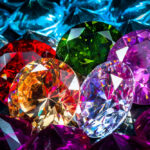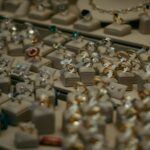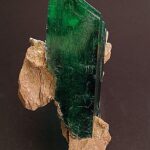Understanding Gem Gender in Steven Universe
Steven Universe is a popular animated series that has captured the attention of millions of viewers around the world. One of its most notable features is its unique portrayal of gemstones. In this show, these precious stones anthropomorph as beings with their own personalities, abilities, and relationships. Like sentient alien life forms and we’ll know the Gem Gender in Steven Universe.
But what exactly does it mean when we say “gem gender”? And how does this concept fit into Steven Universe’s narrative? Let’s dive in deeper to gain a better understanding.
First off, it’s important to remember that “gender” in Stevens Universe doesn’t directly translate to social norms or heteronormative binary male/female attributes. Rather, gender identity in Steven Universe is the philosophy behind universal energy forces— where gems are distinct consciousnesses within celestial bodies.
Just like humans have varying genders due to physical sex characteristics & personal identification. Gems too have varying self-identities even if they’re mostly light projections from hard-light constructs.
In other words, every Gem portrays themselves according to certain personality traits and possessabilities that align with an overall inclinations to an internally formed gender orientation suitable for them rather than society defined categories- which includes female-coded behaviors such as nurturing or aggression/emotional unwavering aspects considered ‘masculine”.
About the Show
The show explores many different types of gems — powerful warriors Lapis Lazuli; brawny Jasper; wise Garnet; compassionate Rose Quartz— who represent various archetypes related broadly enough but not confined exclusively through feminine or masculine energies.
For instance, Amethyst a purple quartz variant whom identifies herself partially as agender is more neutral/masculine. Presenting at times but also shows transformative growth overtime showcasing very vulnerable/human emotions making her relatable regardless. A fan favorite couple depicted often was Ruby and Sapphire who, apart and together present themselves with hyper-specific feminine-coded traits like vulnerability or selflessness yet showcase power while fused as “Garnet”.
To conclude, Steven Universe showcases the charm of gender presentations beyond societal norm fueled stereotypes reiterating to its audience that everyone has their own unique identities based on many factors past the surface level. It teaches us acceptance, empathy in all areas of life through a colorful space-age lens– A beautiful series worth checking out!
Step-by-Step Guide to Recognizing Gender in Gems from Steven Universe
Steven Universe is a show that has captivated audiences with its creativity, heart, and message of inclusivity. One of the many ways it embraces this message is through its depiction of gender in Gems.
Gems are a group of beings who use feminine pronouns but do not have traditional physical genders. This can make identifying their perceived gender seem tricky, but fear not! Here’s our step-by-step guide to help you identify gender in Gems.
Step 1: Pay attention to voice tone
Voice tone can often give us clues about someone’s gender identity. In Steven Universe, masculine presenting characters tend to have lower-pitched voices compared to their feminine presenting counterparts. For example, Garnet (who identifies as non-binary) has a deeper voice than Pink Diamond (who presents herself as female).
Step 2: Observe personality traits
Gender expression isn’t just about how we look or sound – it also influences how we act and present ourselves to the world. Masculine-presenting gems tends towards being more independent and stoic while Feminine-presenting gems tend toward nurturing and emotional behaviors
For instance, Amethyst is one of the most “masculine” looking Gems on the show with her short hair, tough exterior and brash sense of humor while Pearl leans more toward traditionally “feminine” behavior with her tendency towards perfectionism avoidance tactics.
Step 3: Look at design elements
Steven Universe’s creative team uses costume designs and character imagery effectively for showcasing features that typify different aspects associated with masculinity or femininity such as coloring choices like pinks representing traditionally “feminie aesthetics” while blues represent typically male characteristics These types visual clues found throughout helps viewers differentiate between them easily .
For example Yellow Diamond’s ascetic feels very much aggressive, rigid lines making up her form alongside harsh colors shouting authority , whereas Rose Quartz Pink Diamond embodied softness charming demeanor highlighting empathy & compassion using pinks to represent feminine energy .
Step 4: Look for specific cultural references
Steven Universe incorporates a wide range of cultural influences. Cultural norms and expectations can often inform our understanding of gender roles.
For instance, the diamond’s caste system in Gempire society Is a representation of colonialism sexist views. It paints female members as lesser figures than their male counterparts. This makes femininity seem undervalued within context which reinforces the importance of Steven’s message that labels are not inherently important.
This guide is simply a starting point – ultimately it’s up to each individual to determine how they perceive any given character. Always keep open mind when looking at characters on film this will only make your viewing all worth while!
FAQ on the Gender of Gems in Steven Universe: Answering Your Burning Questions
Steven Universe is a wildly popular series from Cartoon Network that has left fans with countless questions about the complex world it creates, including the gender of gems. If you’re new to the show, you may be curious about why gems are a “she” despite being non-binary beings.
To help satisfy your curiosity and explain some of the confusion surrounding gemstones in Steven Universe, we’ve put together a comprehensive FAQ on everything you need to know about their gender identity.
So let’s jump right into answering some burning questions!
Q: Why are gems referred to as “she” if they don’t have gender identities?
A: Although gems do not possess traditional human gender identities (they’re technically sexless), they exhibit more feminine physical characteristics and often present themselves using female pronouns. This is largely due to the fact that creator Rebecca Sugar deliberately designed them this way as an expression of her own beliefs in gender inclusivity and nonbinary representation.
Some fans argue that referring solely to characters like Garnet as “she/her” does not accurately capture their status outside of traditional binary structures. However, others appreciate how these depictions provide another avenue for viewers – particularly young people who may feel alienated by society’s rigid ideas about masculinity and femininity – can see themselves represented positively in media.
Q: Do all gemstones use female pronouns?
A: Not necessarily! Some fan-favorite characters, such Sadie Killer or Frybo- are explicitly in the show using male pronouns. Additionally there’s several examples where Gems seem uninterested in participating entirely within any prescribing conventions. Characters like Stevonnie or Sunstone could arguably use multiple sets entirely or third-person-neutral language without feeling out-of-place at all.
However, most gemstones presented thus far typically tend to align with female pronouns. Presenting a different vision of gender expression than what most viewers see in mainstream media.
Q: Why is Garnet specifically referred to as “she” instead of “they”?
A: Although other characters – such as Stevonnie or Sunstone- use gender-neutral pronouns that might fit more neatly within traditional nonbinary frameworks. Garnet continues to use feminine terminology. This may in part reflect the character’s own personal characteristics; she possesses two distinct physical forms (Ruby and Sapphire), both of which feature typically feminine traits like long hair and elegant curves.
Beyond this though, some argue that designating her solely with female pronoun fits well with how Steven Universe seeks to dismantle singularly prescriptive categorical language categories in general. Rather than reframing Gems altogether within traditionally fixed understandings around masculinity/femininity versus axing out those ideas entirely & leaving themselves without kindred concepts for self-understanding-in-American-society-at-large.
Q: What do gemstones’ relationships tell us about their gender identity?
A: While gems don’t necessarily possess explicit gender identities themselves, they often form close bonds with other beings that can offer new insights into the fluid nature of these constructs. For instance, Ruby and Sapphire express emotion towards each other via coupling up — complete uncoupling heteronormative terms around “romance.” Meanwhile Lapis was key partner formostly-Human-Country protagonist Peridot .
These dynamics can help underscore how conceptions around love/romance/gender presentation are all moving away from adhering one-size-fits-all-expectations , even as society clings onto outdated norms surrounding said topics.
So there you have it! As we’ve learned today, the gender identity of gems in Steven Universe is far less straightforward than some might assume at first glance–but that’s all part of what makes this show so enriching & complex as a whole. From its gorgeous animation style through unconventional-yet-deep characters plus exploration into themes around love/friendshp/self-discovery — Steven Universe remains one-of-a-kind storytelling wonder unlike any other animated series before or since.
Top 5 Facts You Need to Know About Gem Gender in Steven Universe
Steven Universe is one of the most popular series on Cartoon Network, and it’s not hard to see why. The show has captured the hearts of fans all around the world with its deeply relatable characters, stunning animation, and intricate lore. One of the key elements that sets Steven Universe apart from other shows is its unique take on “gem gender.”
If you’re new to the Steven Universe fandom or just want to dig a little deeper into this fascinating topic, then keep reading! Here are the top 5 facts you need to know about gem gender in Steven Universe.
1. Gems Don’t Have Biological Sex
In Steven Universe, gems are sentient beings made out of light who have taken on humanoid form. However, they don’t reproduce sexually like humans do – instead, they “emerge” fully formed from their respective planets. As a result, it doesn’t make sense to assign them biological sex categories like male or female.
This means that some gems may present more traditionally masculine or feminine traits (like Garnet’s muscular build and commanding presence vs Pearl’s slender frame and delicate mannerisms), those attributes aren’t inherently their “gender.”
2. Gems Use Pronouns Based On Their Personal Preferences
Since gems don’t conform to human ideas of gender identity based on physical traits or societal roles associated with sex expression (like clothing choices), they use pronouns based solely on personal preference – for example,
-Amethyst goes by she/her/hers
-Steven uses he/him/his pronouns
-Garnet prefers singular they/them/theirs because she is actually two separate gems together
This approach creates an inclusive framework where you can address anyone without judgement.
3. Fusions Can Be Used To Explore Gender Expression And Identity Fluidity
If we explain fusion as ‘two separate gems combine their bodies into a single entity,’ fusions provide visitors space to explore gender expression and identity fluidity in the Steven Universe universe.
Some brave fans will explore gender for a host of reasons. Fans can experiment with adopting another character’s physical details or clothing. If they’re confident enough, fans can also try embodying genders that don’t conform to traditional binary models. Ultimately transforming themselves into unique gem hybrids – like Garnet who is a combination of two gems Ruby and Sapphire.
4. Non-Binary Characters Are Front And Center
Traditionally, non-binary representation has been minimal – if it’s represented at all- in mainstream animated series but not anymore since Steven Universe came out!
The show features several characters who don’t fit neatly into either male or female boxes:
-Stevonnie: A fusion between Steven and his human friend Connie who identifies as neither strictly masculine nor feminine but rather somewhere in the middle leaning toward societal dysphoria experiences.
– They/Them/Theirs are pronouns for Stevonnie & Smokey Quartez respectively
5.The Crewniverse
The Production Team Values Representations Of Gender Diversity Informed By Discussions Within The Fandom Community.
While every individual artist writing on this show brings their own perspective to contribute an inclusive framework for how they depict Gem narratives around sexuality, attraction,& feelings towards these topics has collectively contributed to some fantastic storytelling over time!
It’s clear that everyone involved from voice actors, designers/artists creators/showrunners take great care not only working closely together as a team when conveying complex issues concerning representation accurately. But they respectfully take consideration fan feedback seriously because they understand fandom members have personal connections and emotionally invested stakes rooted within these characters’ lives!
Breaking Down the Diversity of Gender Representation in Gems from Steven Universe
As a well-known animated TV series, Steven Universe has brilliant storytelling and intricate plotlines. It is no secret that the show’s creators, Rebecca Sugar and the talented writers behind it have managed to craft something truly unique and innovative. However, one of the most notable aspects of Steven Universe’s success comes from their remarkable gender representation in Gems.
Gems are a core component of Steven Universe’s universe, serving as powerful spirits that take physical form when they need to interact with people or objectives beyond their world. They can be formed by any non-living material within a planet’s surface—all while inherently carrying particular traits like magical powers exclusive to this enigmatic species’ abilities.
Gender Diversity
However, what makes Gems so impressive is their incredible diversity in terms of gender representation. The show portrays them not just as individuals but also an emblematic society where there’s enough room for everyone – regardless if they’re male female – or anything else entirely!
The concept of “gender fusion” is introduced quite early on during the series—a visibly interesting development seen between two gems who choose to be together both physically/mentally linked merging into one ultimate being referred to as “fusion.” This introduces different dynamics among characters—sometimes resulting in stronger relationships due to fusing happening mainly consensually through mutual respect.
Fusion acts like another independent character frequently addressing personal struggles along every episode—their experiences mirroring how humans interpret sexual relationships differently across cultures worldwide since events could differ dramatically depending on each gem fused. A clear illustration includes descriptions showing more dominant attributes ranging from different personalities such as competition vs cooperative approach trends between those involved.
Steven Universe showcases various exquisite examples of breaking down traditional binary social norms- all through representing bisexuality proudly represented within these fantastical beings enabling subtextual validity accessible without confining it through verbal explanations only.
Non-archaic Stereotypes
Unlike some other animated television shows which tend towards archaic stereotypes regarding femininity/masculinity, Steven Universe takes a different approach by portraying male and female personages with equal care. Each gem character identified as having their own strengths – ranging from intelligence to physical abilities – making it impossible to overlook them based on gender stereotypes.
In summary, the diversity of gender representation in Gems from Steven Universe magnificently depicts what is achievable through imaginative storytelling. This not only empowers generations of differently oriented individuals who often feel left behind in our society today but also sets an exemplary status quo towards increased inclusivity and understanding within modern media representations. It’s true – anything can be possible when we embrace diverse culture perspectives much more openly!
Exploring the Importance of Non-Binary Representation in Fiction: The Case of Steven Universe
In recent years, there has been a growing demand for greater representation of marginalized groups in popular media. And one group that has often been overlooked is the non-binary community. Non-binary individuals are those who do not identify as strictly male or female. They may see themselves as genderfluid, agender, or fall under other similar labels.
One show that stands out in its efforts to provide positive and relatable non-binary representation is the Cartoon Network hit series Steven Universe. The show features an ensemble cast of complex characters from various walks of life – including aliens and mystical beings – but it’s the portrayal of its two prominent non-binary characters, Stevonnie and Garnet, that deserves special attention.
Stevonnie is a fusion character created by Steven Universe and his human partner Connie after they dance together in harmony. Stevonnie’s appearance reflects their unique identity; with a mix of feminine and masculine traits such as wearing skirts while having facial hair stubble making them stand out from the rest of the show’s characters which all have more traditional binary appearances.
But what makes Stevonnie even more impactful isn’t just how they look but also how confidently they own their identity throughout the series’ run. For example when asked about their pronouns – preferences – they respond “they/them” without hesitation or further explanation needed indicating pride behind this label unlike many people who feel uncomfortable disclosing this information to others unless prompted specifically for it.
More Gender-Appropriate Examples
Garnet is another compelling example; She is seen loving herself exactly how she wants despite societies trying to stereotype them based on gender expression.People often consider her character to be so completely removed from any kind of binary definition whatsoever stating “I am an experience”, focusing on experiencing life rather than getting overwhelmed by societal constructs observed through norms she can’t associate herself with since she doesn’t embody them entirely anyhow due to her exclusive form
This level of visibility can make all the difference for someone struggling to find themselves in the media they consume. Non-binary people are often left out or poorly represented altogether in mainstream media.
The importance of better non-binary representation in fiction is a fact. It’s about more than political correctness. When marginalized communities see themselves portrayed respectfully onscreen, it has a profound positive effect on their mental health by providing visibility for experiences that might not have been known before.However this is just the start. There is still much work to do when it comes to providing quality representations of all minorities across fiction.
Table with useful data:
| Gem Name | Gender |
|---|---|
| Amethyst | Female |
| Aquamarine | Female |
| Bismuth | Genderless |
| Blue Diamond | Female |
| Emerald | Female |
| Garnet | Genderless/Female |
| Jasper | Genderless/Female |
| Lapis Lazuli | Genderless/Female |
| Peridot | Genderless/Female |
| Pink Diamond | Female |
| Rose Quartz | Genderless/Female |
| Ruby | Genderless/Female |
| Sapphire | Genderless/Female |
| Steven | Male (Half-Gem) |
| White Diamond | Female |
| Yellow Diamond | Female |
![Uncovering the truth: are all the gems in steven universe female? [exploring the gender dynamics and diversity of gem characters] - gulfgemology Gem gender in steven universe](https://gulfgemology.com/wp-content/uploads/2023/05/tamlier_unsplash_Uncovering-the-Truth-3A-Are-All-the-Gems-in-Steven-Universe-Female-3F--5BExploring-the-Gender-Dynamics-and-Diversity-of-Gem-Characters-5D_1683136132.webp)
![Unlocking the hidden benefits of aquamarine gems: a personal story and data-driven guide [expert tips included] - gulfgemology](https://gulfgemology.com/wp-content/uploads/2023/05/tamlier_unsplash_Unlocking-the-Hidden-Benefits-of-Aquamarine-Gems-3A-A-Personal-Story-and-Data-Driven-Guide--5BExpert-Tips-Included-5D_1683136133-150x150.webp)
![Unveiling the mystery: how to awaken the sleeping veil stone below the gem [a guide with stats and stories] - gulfgemology](https://gulfgemology.com/wp-content/uploads/2023/05/tamlier_unsplash_Unveiling-the-Mystery-3A-How-to-Awaken-the-Sleeping-Veil-Stone-Below-the-Gem--5BA-Guide-with-Stats-and-Stories-5D_1683136131-150x150.webp)




